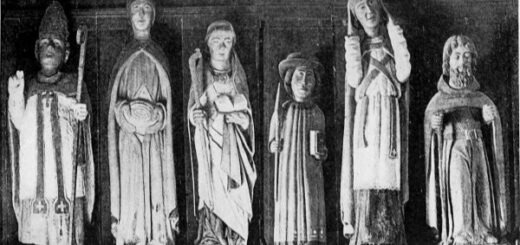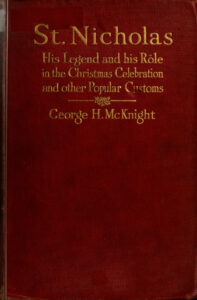St. Nicholas – His Legend and His Role in the Christmas Celebration and Other Popular Customs (By George H. McKnight, 1917) – Chapter 9

CHAPTER IX
PAGAN HERITAGE OF ST. NICHOLAS
It is well known that when paganism was superseded by Christianity, the older religion was by no means obliterated. In Greece the pagan temples often were converted into Christian churches. At Athens, the Parthenon, a temple of the Virgin Pallas, became a church of the Virgin Mary; the temple of Theseus became a church devoted to a Christian hero, also a dragon-slayer, St. George of Cappadocia. In the structure of new churches, material from the older temples was freely used. In many of the churches of Rome may be seen beautiful classical columns taken from the earlier pagan structures. A fine instance of the mingling of elements, old and new, in Christian architecture, is to be seen at Syracuse in Sicily, where the older classical temple of Minerva has been transformed into a renaissance cathedral. The columns of the Doric temple are built into the wall of the church but are too thick to be concealed. On the outside they may be seen, at times a protruding Doric capital, at times a whole Doric column; within the church, they form a line of magnificent weathered columns bordering the outer side of each aisle. In this church, to the Christian and pagan combination, is superadded a third element, in the form of rounded Saracenic battlements.
The hybrid nature of this Christian architecture in the countries pervaded by classical civilization finds a striking parallel in the Christian practices and Christian beliefs of these countries. In these, too, there is evident a mingling of elements new and old, Christian and pagan, with here and there a tinge taken on from later forms of non-Christian religion, corresponding to the Saracenic element in the architecture of the cathedral at Syracuse. Just as the graceful classic columns survive as beautiful features in the Christian churches, so, many fair products of the poetic imagination belonging to the earlier faith have found a place in the Christian religion. This is particularly true in the case of the saints, who continue to exert over the forces of nature the same control in the interests of man that the minor gods and demi-gods had done before.
In modern Greece there is to be found ample illustration of Christian appropriation of the old. When gods have not been directly transformed into saints, at least many of their attributes have been taken over. In the island of Naxos, St. Dionysios is widely worshiped, and like the god of similar name, is connected in popular story with the origin of the wine. There is a story of the journey of the saint from Mt. Olympos to Naxos, in which there is assuredly more of the pagan than of the saintly quality. “He [St. Dionysios] noticed an herb by the way and planted it in the bone of a bird, then in the bone of a lion, and lastly in the bone of an ass. At Naxos he made the first wine with its fruit. The intoxication which followed the drinking of this wine had three stages: first, he sang like a bird; then, felt strong as a lion; and lastly, became foolish as an ass.” In a similar way, St. Demetrios, as the popular patron of Greek husbandmen and shepherds, and the protector of agriculture in general, assumes the functions of the Earth-Mother, Demeter, and St. Artemidos, as patron of weakly children, has taken over some of the attributes of Artemis, to whom belonged protecting powers over children, animals, and vegetation. Still better known is the case of St. Elias, who has acquired many of the attributes of the sun-god, Helios. “It would be difficult to find any spot in Greece from which one could not descry on a prominent hilltop a little white chapel dedicated to him, where at least once a year, on the 20th of July, a service is held. This hilltop saint is believed by the peasants to be lord of sunshine, rain, and thunder.”
Venus, too, finds her place in Christian worship under the name of St. Venere. In West Albania, where the practice has been imported from the south of Italy, “she is invoked by girls as patroness of marriage.” In the territory of St. Sophia, in Calabria, her festival is celebrated on the 27th of July, and the girls sing a song, in substance “a prayer to St. Venere not to leave them husbandless now that all their companions are married and gone.” St. Merkurios, also, has many of the attributes of the pagan god Mercury. There is an ancient story in which the saint plays the rôle of messenger formerly assigned to the god. Basil, Bishop of Cæsarea, in a vision, saw the heavens open, revealing Christ enthroned. “Then Christ called, ‘Merkurios, go and slay Julian the King, the persecutor of the Christians.’ And St. Merkurios stood before Him wearing a gleaming iron breastplate, and on hearing the command, he disappeared. Then he reappeared and stood before the Lord and cried, ‘Julian the King has been slain as Thou didst command, O Lord.’”
In many other cases, where the direct pagan inheritance is not so easily traced, saints in modern Greece accomplish functions precisely similar to those accomplished in ancient times by minor deities. St. George is regarded as the protector of the crops, probably on account of the etymology of his name (Ge=“earth,” ergein=“work”). For a similar reason, apparently, St. Maura is invoked in case of ulcers or smallpox. Other saints with similar functions are St. Madertos invoked in case of pestilence among beasts, St. Blasios in case of sore throat, and St. John in cases of fever.
People accustomed to seek divine aid in this way, in case of trouble, are not easily to be deprived of their recourse. If they are forbidden to worship their pagan divinities, then substitutes must be found. Thus seamen deprived of Poseidon as source of aid, had recourse to St. Phokas and later turned to St. Nicholas, possibly, as has been pointed out, due to the story, in the legend of St. Nicholas, of aid rendered by him to the ship in distress. The connection once established, St. Nicholas came more and more to occupy the place formerly held by Poseidon. Hence probably the position held by St. Nicholas in popular belief, especially in eastern Christendom, as the guardian of sailors.
There is one modern Greek story of St. Nicholas as patron saint of seamen which deserves to be told because it shows the occasional survival, in the popular worship of saints, of pagan elements which the Christian Church could not countenance. The story, as told by an old Greek man, is to this effect: “At the time of the Revolution a number of Greek ships assembled off Kamári. There was great excitement and trepidation. So they thought things over and decided to send a man to St. Nicholas to ask him that their ships might prosper in the war. They accordingly seized a man and took him to the large hall at Kamári. There they cut off his head and his hands, and carried him down the steps into the hall.” This was a pagan rite obviously not to be tolerated by the Christian God, for the story goes, “thereupon God appeared with a bright torch in his hand, and the bearers of the body dropped it, and all present fled in terror.”
It is evident that St. Nicholas inherited some of the attributes of Poseidon, or Neptune. But that does not sum up the extent of his pagan heritage. Probably earlier than the association of St. Nicholas with Poseidon is that with Demeter, or Diana, whose cult was particularly in vogue in Lycia, the scene of the principal events in the story of St. Nicholas.
In the Eastern Church there were two celebrations in honor of St. Nicholas, not only the one on the 6th of December, but one on the 9th of May. The May celebration, which is still kept up by Italians, even in America, is usually said to be in honor of the removal of the relics of St. Nicholas to Bari, but not unlikely is the continuation of the Rosalia, a local pagan spring festival at Myra, the Lycian home of St. Nicholas. Not only in Lycia, but elsewhere, the St. Nicholas cult supplanted the earlier worship of Artemis. In Ætolia “at the village of Kephalovryso, there is a little ruined temple of St. Nicholas which, according to an inscription built into the church, stands on the site of a temple of Artemis. Another instance of the same transference occurs at Aulis, where a little Byzantine church of St. Nicholas has replaced the Artemisium.”
Following the substitution of the Christian worship of St. Nicholas for the pagan worship of Artemis, there were two natural consequences. In the first place the pagan deity, formerly revered, came to be regarded as an evil spirit. In the second place this evil spirit was supposed to be particularly hostile to the Christian saint that had replaced her in popular worship. This hostility is reflected in the well-known story of the devil’s plot against the church of St. Nicholas. The Golden Legend version of the story is as follows:
And in this country the people served idols and worshiped the false image of the cursed Diana. And to the time of this holy man, many of them had some customs of the paynims, for to sacrifice to Diana under a sacred tree; but this good man made them of all the country to cease then these customs, and commanded to cut off the tree. Then the devil was angry and wroth against him and made an oil that burned, against nature, in water, and burned stones also. And then he transformed him in the guise of a religious woman, and put him in a little boat, and encountered pilgrims that sailed in the sea towards this holy saint, and areasoned them thus, and said: I would fain go to this holy man, but I may not, wherefore I pray you to bear this oil into his church, and for the remembrance of me, that ye anoint the walls of the hall; and anon he vanished away. Then they saw anon after another ship with honest persons, among whom there was one like to S. Nicholas, which spake to them softly: What hath this woman said to you, and what hath she brought? And they told to him all by order. And he said to them: This is the evil and foul Diana; and to the end that ye know that I say truth, cast that oil into the sea. And when they had cast it, a great fire caught it in the sea, and they saw it long burn against nature. Then they came to this holy man and said to him: Verily thou art he that appeared to us in the sea and deliveredst us from the sea and awaits of the devil.
But the victory over the pagan deity was not a complete one. Constant association of St. Nicholas custom with earlier worship of Artemis was not without its influence on the popular conception of the Christian saint. One is tempted to assume the malevolent and insidious work of the pagan deity aiming to corrupt the character of the benevolent bishop. In any event from Artemis as well as from Poseidon St. Nicholas inherited attributes which serve to explain some of the elements in his complex personality. It is to be remembered that Artemis of Ephesus was not only a spring deity but also in part a sea and a river goddess. Hence her epithet, “Potamia.” Both associations, that with spring, and especially that with the sea, Artemis shares with St. Nicholas. Artemis-Cybele is often represented as a sea monster with the tail of a fish. There are traces of a similar grotesque popular conception of St. Nicholas in the Sicilian popular legend with the hero named Nicolo-Pesce. This conception of St. Nicholas is much in evidence in western Europe and serves to explain the connection of St. Nicholas with a conception widely prevalent there, of a water spirit or god. Among Teutonic peoples, particularly, this water spirit is widely known with various names, such as Nix, Nickel, Nickelman, Nick, Nökke. Millers are said to be particularly afraid of this spirit and to throw different things into the water on the sixth day of December, St. Nicholas’ day, to propitiate it. In the character of Nikur, a Protean water sprite (Edda, Doemesaga, 3), he inhabits the lakes and rivers of Scandinavia, where he raises sudden storms and tempests and leads mankind into destruction. Danish peasantry, in earlier times, conceived of the Nökke (Nikke) as a monster with human head, dwelling both in fresh and in salt water. Where anyone was drowned, they said, Nökken tag ham bort, “the Nökke took him away.” The Icelandic Neck, a kelpie or water spirit, appears in the form of a fine horse on the seashore. If anyone is foolish enough to mount him, he gallops off and plunges into the water with his burden.
In France there is known a similar water monster, and there, paradoxical as it may seem, it has taken the name of the benevolent St. Nicholas. It is a terrible monster that seizes fishermen who walk without permission by the water side at nightfall. It has claws and tears the faces of the children that remain too late on the beach.
The water monster under discussion was known in England. Back in the eighth century, in the story of Beowulf, there are introduced water monsters, apparently conceived of as like walruses or sea-lions, but malevolent in character. These are called niceras. The “Old Nick,” a name familiar since the early seventeenth century, seems to have originated in the conception of this water monster once prevalent in the North of England. The conversion of the name of the water demon into a name for the Devil is not an unusual phenomenon. The process is illustrated in the history of the Greek word “demon” itself, which, at first meaning “spirit,” in no evil sense, with the hostile attitude assumed toward earlier religious conceptions following the introduction of Christianity, came to be used as a name for an evil spirit or devil. The same conversion of an old name to a new use is to be seen in the case of the “Old Nick,” in the beginning the name of a water spirit, later a name for the Devil. In this case the malevolent character of the water spirit made the conversion one easy to comprehend.
What, then, is the relation of this well known, usually malevolent, water spirit to St. Nicholas? An attempt has recently been made to show that the Eastern conception of St. Nicholas as a water spirit, originating in the older mythical beliefs concerning Artemis, was carried by seamen to the West of Europe and that in this way the name St. Nicholas is the base of the different forms for the name of the water spirit. This theory can hardly be sustained, since there is no proof of the popularity of St. Nicholas in the West so early as the earliest reference to the water spirit, that is to say, in the case of the niceras of the English Beowulf, and because in popular contraction of the name Nicholas, it is the second part of the name, the -clas, that usually survives. A more likely explanation is that the confusion between the water spirit, variously known as Nick, Neck, Nicor, Nökke, Nickel, Nickelmann, and St. Nicholas, is explained by a well-known process of popular etymology. St. Nicholas with his attributes as controller of the waters, inherited from the mythical Poseidon and Artemis, when in the eleventh century he became known in the West, became confused with the more and more vaguely conceived pagan water spirit of similar name, and in the end, in certain places, became identified with him, thereby inheriting some of his qualities, and influencing the form of his name.
Over in Russia also St. Nicholas has fallen heir to similar attributes. In this way he has come to figure in an interesting episode in recent musical history, an episode which illustrates in a most interesting way how the influence of St. Nicholas has penetrated to affairs of our own time. Rimsky-Korsakoff, in his opera, Sadko, composed in 1896, made use of an old Novgorod folk-tale of the Volga. This story centers about a river deity said to be something like the Old Man of the Sea in the Arabian Nights Tales. Under Christian influence this tale has been converted into a story of St. Nicholas, one of many told of him in Russia, where he is one of the most popular of the saints. Both versions of the popular story persist, the earlier, pagan form and the one where St. Nicholas has inherited the prominent part. Rimsky-Korsakoff, after some hesitation which of the two versions to use, finally made choice of the later, St. Nicholas, version. But here he came into conflict with Russian orthodox bureaucracy, which would not permit such irreverent use to be made of the Russian patron saint Nicholas. The composer, therefore, made a change, substituting the names of the older version. But in his opera he had made free use of musical themes derived from the liturgy of the St. Nicholas festival, and this music he retained, making a humorous incongruity between the sacred music and the pagan story. A quarrel with officialdom resulted, which is said to have been one of the reasons why Rimsky-Korsakoff lost his position as Director of the Conservatoire at Petrograd.
Attempt has been made to connect St. Nicholas, through his relationship to the Teutonic water spirit, with Odin, who in one of the Edda poems is given the name Hnikar. This particular link between St. Nicholas and Odin has not been successfully established. It is certain, however, that a relationship exists. The time of the St. Nicholas festival, December 6th, and of Christmas, where St. Nicholas has come to play an important part, coincides in part with the season of the year when Odin, as god of the air, made his nightly rides, or, as god of the dead led through the air the troops of spirits of departed ones. The coincidence in time, under Christian influence, led to the transfer to St. Nicholas of some of the functions of Odin. The heritage of St. Nicholas from Odin has been discussed in an earlier chapter. From Odin St. Nicholas inherited his gray horse, which in some Germanic countries he uses in his nightly rides, but which he traded for a reindeer before coming to America. For this horse of St. Nicholas children in parts of Europe leave the hay and oats once left for the horse of Odin. From Odin, too, Santa Claus inherited certain details of his appearance, most notably his long white beard as distinguished from the kind of beard familiar in pictures of the bishop-saint.
From others of the Teutonic gods St. Nicholas received legacies. In him various scholars have recognized attributes of Fro and of Niordhr, the father of Fro. The task of purveying gifts for children, for which St. Nicholas uses the horse of Odin, is a function sometimes attributed to the spirits of the dead, who, with or without Odin as a leader, in the time of the shortest days of the year are supposed to revisit their earthly homes.
From this discussion one will see that the Christian saint Nicholas has the same perplexing variety of aspects that make it so difficult to form any single unified conception in the case of one of the pagan gods. At Bari, in Italy, where his relics are preserved, on his festival day, he receives the honors of a water god not necessarily malevolent in character. His image is borne by sailors in procession out to sea and at nightfall is escorted back to the cathedral with torches, fireworks, and chanting. In parts of France he has inherited different qualities; his name is given to a water spirit, a veritable ogre in its malevolence. In many other countries, including our own, he has inherited the pleasant rôle of children’s benefactor. If one wishes to gain a realization of how popular heroic conceptions are formed, one should compare the many-sided St. Nicholas known in our own day in the various countries of Christendom with the simple figure, as clearly as one may distinguish it, of the kindly youth that was born at Patras in Asia Minor in the early days of Christianity.

















